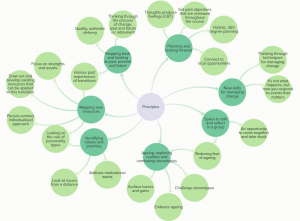Transitions in Later Life learning community: March 2017

Over its first year in 2016, the learning community became a cohesive group and focused on sharing reflections on their own work as it developed in this first phase of funding. Our fourth learning community meeting – and first of 2017 – was held in March 2017. One year into our work together, the pilot projects run by members of the learning community had come to a close. At this meeting we were excited to plan our next steps, which involved thinking about different ways of scaling the impact and ambitions of the TiLL programme with our partners.
Scaling social impact
Spring Impact kicked off the first day with a session on scaling social impact. After discussing different models for scaling and replication, we reflected on what scaling meant for TiLL partners:
- Reaching and supporting more people
- Challenging stereotypes/narratives
- Influencing policy
Spring Impact helped us think through our individual strategic goals, before thinking about replication and how that can support scaling. Examples of individual strategic goals included helping people to plan and have a positive later life, and improving people’s health and wellbeing through peer support. We then discussed the ‘readiness test’, which helps to identify key gaps before embarking on scale.
Identifying common ground
All the organisations in the community are developing group workshops for people in mid- to later-life, which focus on building resilience and emotional wellbeing. As this work is being developed in different settings using different approaches, we were interested in understanding what the projects have in common. We mapped the principles that the projects share – their approaches and their beliefs about change – and found the following similarities:
- All the projects saw reframing aging in a positive light as important
- The courses all draw out and focus on participants’ wants/needs and strengths/assets
- The courses empower people to make use of the opportunities or resources available to them to and develop skills to improve their own resilience
- The projects all acknowledge transitions, like retirement, as emotional processes and the need to also deal with fears, grief and loss during times of change.
Setting our direction
At the close of the two days, we discussed our vision for the community:
- Developing our external presence of the learning community, sharing across networks and increasing our influence to work together to have influence
- Preparing to be flexible, stay relevant and to be sustainable, particularly as the practical landscape around ageing changes
Stepping back to consider our individual goals helped us to focus on the direction that the learning community is taking, and where we want it to go. We all left the meeting feeling excited for the next stage and ready to scale our impact.

